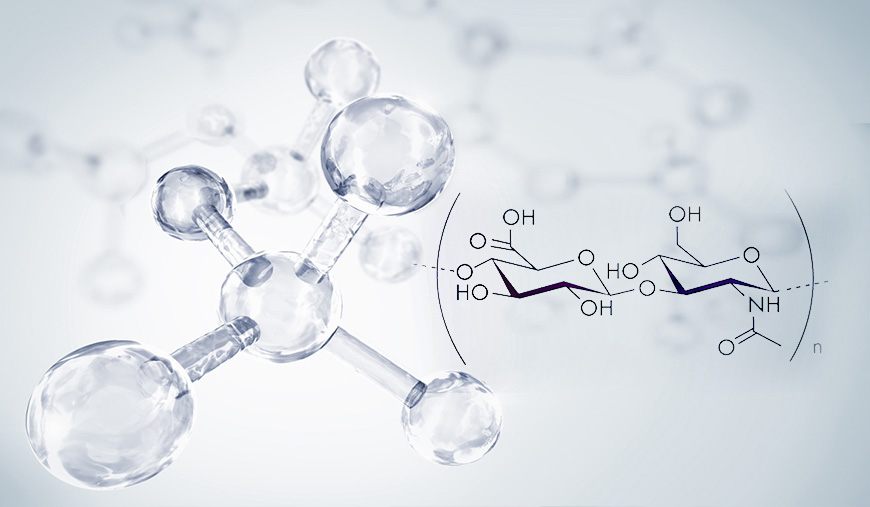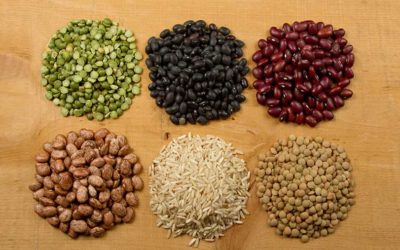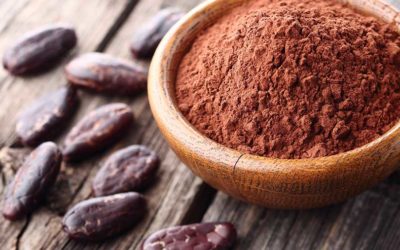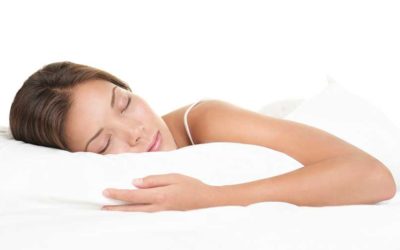The hyaluronic acid is a glycosaminoglycan (GAG) consisting of the repetition of disaccharide units of d-glucuronic acid and N-acetyl-D-glucosamine. It represents the main component of the extracellular matrix (ECM) , and it is a very large molecule with a molecular mass greater than 4000 kDa capable because of its structure to trap large amounts of water molecules, tying up to 1000 times its weight. Due to its chemical-physical characteristics, it is able to maintain the skin elastic and it gives firmness to the tissues. It is widely distributed in the body, we find it in the vitreous body, in the umbilical cord, in the synovial fluid, in the joints, in the skin, in the heart, in the vessels, in the nails and in the urogenital apparatus. It is synthesized on the inner surface of the cell plasma membrane by enzymes that take the name of hyaluronic acid synthase (HAS1, HAS2 and HAS3) and degraded by a mechanism of hydrolysis by proteins that take the name of hyaluronidase, which fundamental role is to separate the hyaluronic acid molecules with a high molecular mass in order to allow the carrying out of its multiple functions.
The hyaluronic acid is in fact capable of binding covalently to its specific receptors CD44, RHAMM and ICAM, through which it interacts with other cellular processes and it performs different activities: remedial, lubricants, barrier, proliferation of damaged tissue and regeneration.
The hyaluronic acid is continuously produced in the body and allows the maintenance of normal tissue functions. With ageing process, or in the presence of particular conditions, its production decreases leading to the appearance of problems such as skin aging, skin loss of firmness and elasticity, the onset of joint problems and vaginal affections. Because of its characteristics it is used in several areas: it is widely used in articular therapies, in dermatology, in case of skin injuries, wheals or burns, but also in gynecology for women’s health and in the field of urology in both men and women.
USE
VAGINAL AFFECTIONS
For vaginal affections shall mean a series of disorders caused by an alteration of the normal physiological conditions of the vaginal mucosa which in turn leads to an increased possibility of attack by viruses, bacteria and antifungal agents.
Vaginal affections may be due to several factors: morphological alterations such ad ectopy, metaplasia, hyperkeratosis or due to lack of estrogens, as occurs during menopause and even physical and chemical treatments, such as DTC, laser therapy, radiation therapy, which are predisposing factors to possible pathogens attack.
This involves changes in the epithelium composition and structure, which shows itself with the typical signs of vaginal affections characterized by symptoms such as redness, dryness, itching, burning, dyspareunia, erythema, oedema, ulcerations, bleeding.
There is thus a loss of integrity of the vaginal tissue and one of the substances primarily involved in this process is the hyaluronic acid.
Several studies show in fact the way in which the hyaluronic acid, interacting with its receptors, is able to repair a tissue damage and to restore normal physiological conditions of the vaginal mucosa, intervening at all stages of the restoration of the epithelium: creating a structure of support for the cell anchorage; inhibiting the flow of water on the cell surface; modulating the inflammatory response through the release of cytokines such as IL – 6, TNF and IL – 1β; inducing angiogenesis, migration and proliferation of keratinocytes and fibroblasts during the phases of proliferation and re-epithelization.
Supplementation with hyaluronic acid topically or orally can make an important contribution to the resolution of vaginal affections and to the relating symptoms. In order to be effective, hyaluronic acid, however must be at a very low molecular mass, scientific studies show in fact that only a hyaluronic acid with a molecular mass lower than 300 kDa is able to penetrate tissues and repair the tissue damage, while larger molecules can only act superficially. Moreover, further investigations have shown that hyaluronic acid molecules with a very small molecular mass can overcome the intestinal barrier and thus act systemically distributing itself in the various parts of the body that need it.
Unlike the current therapies involving the use of lubricant gels that act only in a superficial way and for a short period of time or the use of hormone replacement therapies, which can lead to side effects, hyaluronic acid makes its restoring action in depth, in a more durable way and it is completely biocompatible.
UROTHELIUM ALTERATIONS
The urothelium is a type of epithelial tissue that forms the lining of the bladder and urinary tract. It is composed by a three-layered structure: basal, constituted by cubic epithelial cells; medium, which presents cells clavate; and superficial, it consists of umbrella cells which can also be binucleated. This structure has to contain varying volumes of liquid, so it can also extend.
The urothelium integrity, its barrier function and its elasticity, are guaranteed by the presence of glycosaminoglycans or GAGs (hyaluronic acid and chondroitin sulfate), which form the so-called “coating urothelial” with the function of increasing the pelvic floor impermeability and limiting the penetration of harmful substances such as viruses and bacteria.
The GAGs’ absence leads to an urothelial dysfunction characterized by a thinning of the bladder mucosa with consequent loss of its normal physiological function. Thus may occur cystitis both bacterial or not, stress incontinence, loss of pelvic floor tone, as well as pain and inflammations. The presence of hyaluronic acid is therefore essential for the maintenance and restoration of epithelial tissues.
In fact, clinical studies show that supplementation of exogenous hyaluronic acid helps protect, repair and restore the bladder coating in both men and women, reducing the risk of recurrent cystitis both bacterial or not by increasing the pelvic floor tone and reducing the inconvenience due to urinary incontinence and pain.
The oral hyaluronic acid can therefore be useful as an adjuvant in order to counteract urological problems, improving the tropism of the districts of the bladder tissue, including the pelvic muscles and leading to an improved quality of life, as the social distress that these problems can cause.
BIBLIOGRAPHY
Laurent T.C. et al. Immunology and Cell Biology 1996;74:A1-A7.
Dianhua J. et al. Physiol Rev 2011;91:221–264.
Bachmann G. A. et al. Am Fam Physician 2000;61(10):3090-3096.
Costantino D. et al. Eur Rev Med Pharmacol Sci 2008;12(6):411-6.
Maharjan A.S. et al. PLOS One 2011;6(10):e26078.
Ghazi K. et al. PLOS One 2012;7(11):e48351.
Nozomi H. et al. Biosci Biotechnol Biochem 2008;72(4):1111-1114.
La Galia T. et al. International Journal of Clinical Medicine 2014;5:617-624.
Madersbacher H. et al. Neurourology and Urodynamics 2013 32:9-18.
Insights
Inositol
Inositol is a 6 carbon atoms cyclic polyalcohol. It was isolated for the first time from animal muscle by J.J. Scherer in 1850. Inositol is found in many foods, particularly in cereals, nuts,...
Cocoa polyphenols
Cocoa polyphenols are natural substances present in the cocoa powder obtained by the working of the Theobroma Cacao tree. Cocoa polyphenols are compounds known since ancient times for their...
Melatonin and female fertility
What is Melatonin Melatonin or N-acetyl-5-methoxytryptamine is a naturallipophilic substance produced and secreted in our body mainly by the pineal gland (epiphysis). This gland is situated below...




